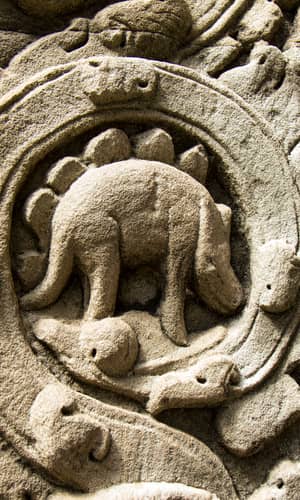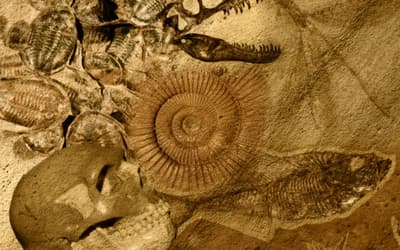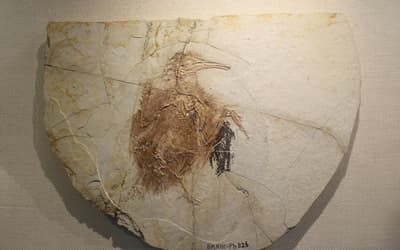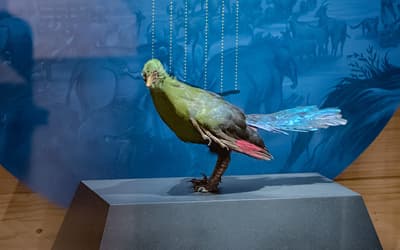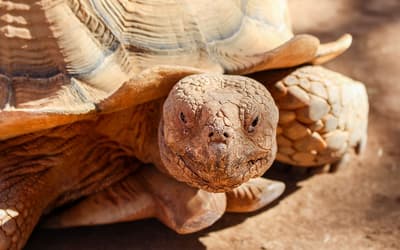The views expressed in this paper are those of the writer(s) and are not necessarily those of the ARJ Editor or Answers in Genesis.
Abstract
One bas-relief carving from the 12th–13th century Ta Prohm temple in Angkor, Cambodia has become famous in the biblical creationist community as a possible artistic depiction of a recently living stegosaur. Despite its wide usage in young-earth creationist books, articles, and presentations as evidence for the recent coexistence of dinosaurs and man, there are a number of significant problems and questions surrounding the interpretation of the carving as a stegosaur. The objective of this paper is to review each of these issues, highlighting the difficulties with the stegosaur interpretation, and to caution creationist writers against using this artifact as evidence for the recent coexistence of dinosaurs and man.
Keywords: dinosaur and human coexistence, dragon artifacts, ancient dinosaur depictions, arguments creationists should not use
Introduction
For many biblical creationist speakers and authors, written historical and archaeological evidence is an important piece of evidence used to support the biblical notion of the coexistence of dinosaurs and humans. One such piece of evidence that has been consistently cited as an example of this phenomenon is a 12th–13th century bas-relief carving depicting a creature that some have interpreted as a possible stegosaur (see Fig. 1 [Patton 2006; Cole 2007]). Creationist authors O’Brien and Doyle (2013) describe the carving as clearly depicting “the main elements for a stegosaurian dinosaur . . . namely the strongly arched back and dinosaurian body, and, crucially, the plates along the back of the animal. No other creature known, fossil or living, has a row of such characteristic plates along its back.”

Figure 1. An 800 year old carving of what many creationist authors have interpreted as a stegosaur. http://creation.com/did-angkor-really-see-a-dinosaur.
Given that the systematic excavation of dinosaur remains is a very recent development (beginning in the 19th century) and that accurate reconstructions of dinosaurs (and particularly the vertical nature of stegosaur plates [Bakker 1986]) have only been accomplished within the last few decades, the possibility that this “stegosaur” carving represents a 12th to 13th century reconstruction based on fossils is highly unlikely (though this has not kept some anti-creationist authors from speculating that this was the case (Kuban 2014). Some creationist authors have therefore argued that the most likely explanation for this carving is that the ancient Khmer peoples saw and depicted a living stegosaur, confirming the view held by many biblical creationists that dinosaurs and humans coexisted in the recent past. As to be expected, some anti-creationist critics have written articles attempting to rebut these arguments (Kuban 2014; Switek 2009), and some of their claims have been responded to by creationist authors (O’Brien and Doyle 2013). In this present study, we will examine the claims of the critics, as well as the defenders, of the stegosaur interpretation. It is the contention of this author that this investigation reveals significant problems with this interpretation, which compromises its ability to serve as evidence for the recent coexistence of dinosaurs and humans.
As a starting note, the author recognizes that many creationist authors have avoided dogmatism by carefully stating that the carving may possibly be a stegosaur or that it is stegosaur-like. For efficiency’s sake, the author will use the undifferentiated term “stegosaur interpretation” to encompass all such positions.
Limits Of The Present Study
The author has not personally examined the “stegosaur” carving or its context, thus, the current evaluation is confined to dealing with limited photographic evidence. A number of the points raised in this paper, particularly those regarding the depth of relief and relative stylistic elements of the “back plates,” could be clarified and improved with the availability of further photographic evidence and in-person examination of the carving and its context. The author encourages further examination of the carving in order to test the claims of both the critics and defenders of stegosaur interpretation, as well as the claims of this paper.
Evaluating The Evidence: Stegosaur Or Not A Stegosaur?
It is necessary to put forward certain criteria for evaluating the relative strength of the stegosaur interpretation. Defenders of this interpretation contend that the artist who carved the creature in question intended to depict a post-Flood member of the Stegosaur kind. From this perspective, we would expect the carving to possess traits found exclusively in members of this kind while lacking characteristics of other types of animals. This prediction can be framed as three separate questions, each of which will be addressed in turn in the following paragraphs.
- Does the creature depicted in the carving possess traits that are characteristic of stegosaurs?
- Does the creature lack certain traits that are characteristic of stegosaurs?
- Does the creature possess traits that are not characteristic of stegosaurs?
“Stegosaur back plates” reconsidered
First, “Does the creature depicted in the carving possess traits that are characteristic of stegosaurs?”
The main features of the carving that have been noted for their similarity to stegosaurs are 1) the row of apparent “back plates,” 2) the creature’s strongly arched back, and 3) the animal’s upright posture, with its legs positioned directly underneath its body. Since the latter two characteristics are not strictly unique to dinosaurs, but are also present in numerous mammal species, the attention of this section will focus on the first and most important characteristic, the back plates. O’Brien and Doyle (2013) emphasize the importance of these plates in their defense of a stegosaur interpretation, noting that, “No other creature known, fossil or living, has a row of such characteristic plates along its back.”1
Some critics have pointed to the similarity between the “back plates” and the leafy ornamentations that line the margins of other carvings (including the water buffalo carving immediately above the “stegosaur” carving; see Fig. 2) as evidence that they are not to be taken as part of the actual creature, but rather as artistic adornments. In response to these claims, O’Brien and Doyle (2013) write, “[T]he plates along the back of the animal are unlike all the other decorative designs in the temple walls. The plates are also seen to hug the line of the back, and follow its curve exactly. The shape of the plates is quite similar to that of known fossil stegosaur plates. Furthermore, the creature’s plates have a noticeably higher relief than the background ornamentation seen immediately above the water buffalo.” (Emphasis in the original)

Figure 2. Immediately above the “stegosaur” carving is a depiction of a water buffalo, which also possesses a “leafy” outline along its back. http://www.bible.ca/tracks/tracks-cambodia.htm.
From photographs, it does appear that the “plates” have a relatively less-decorative, simpler form than those that line the margins of the circular borders that surround the carving, as well as those that abut the water buffalo carving. However, this point is likely equivocal, as the decorative flourishes observed in the available photographs display a variety of different shapes, sizes, and levels of detail (see Fig. 3). The relative difference in style could be due to the diminutive size of the “back plates” in comparison to the larger decorations that adorn the water buffalo and outer margins of the decorative circles that surround each carving.

Figure 3. The immediate context of the “stegosaur” carving. Both the creature above (a water buffalo) and below the carving possess “leafy” decorative outlines along their borders similar to the so-called “stegosaur plates.” Notice that similar designs are also seen along the outside border of the circles surrounding each of the carvings. http://creation.com/did-angkor-really-see-a-dinosaur.
Another point that O’Brien and Doyle give in favor of the “back plate” interpretation is the manner in which the “plates” closely follow the line of the creature’s back. However, this point is also questionable. From photographs, it appears that the decorative leafy flourishes closely follow the back of the water buffalo immediately above the “stegosaur” carving. In Patton’s article (2006) on the carving, he includes a photograph of a swan relief that also appears to have a series of decorative flourishes flanking its outer margins (see Fig. 4). The photographic evidence here is limited, so a complete comparison and analysis is not feasible. However, from what is available, it does appear that decorative flourishes are also found in close association with their respective carvings.

Figure 4. A carving of a swan from Ta Prohm. Notice the outline of decorative “leafy” patterns along the outer margins of the creature, extending from the base of the neck to the tip of the bill. http://www.bible.ca/tracks/tracks-cambodia.htm.
The argument regarding the plates’ depth of relief, like the other arguments examined thus far, also appears to be equivocal. Fig. 5 provides an oblique view of the carving, which enables the viewer to more closely examine the plate’s relative depth of relief. Though comparatively higher than the decorative flourishes that flank the margins of the water buffalo and swan, the relief of the “back plates” is still deeper than that of the carved creature. How should we interpret these differences in depth? Without more examples available for comparison, it is not possible to fully answer this question.

Figure 5. An oblique view of the carving. Though not as deep as the decorative flourishes that adorn the water buffalo and swan carvings, the relief of the “back plates” is still deeper than that of the carved creature’s body. http://www.bible.ca/tracks/tracks-cambodia.htm.
At best, the above arguments in favor of the “plate” interpretation are disputable, and the alternative explanation that they represent artistic decorations still remains a viable possibility.
The importance of the missing tail spikes
Next, we will address the question, “Does the creature lack certain traits that are characteristic of stegosaurs?”
Critics have pointed out that the carving lacks the tail spikes characteristic of all known stegosaurs. In response, O’Brien and Doyle have written, “Some have pointed to the carved image apparently lacking tail spines as being a problem, but there is known variation in size and number of tail spikes in Stegosauridae.” While true, this argument can also be used against the stegosaur interpretation: since all sufficiently-represented stegosaur genera possess tail spikes (Weishampel, Dodson, and Osmolska 2004), and some genera (such as Huayangosaurus and Tuojiangosaurus) actually possess more spikes than plates, why does this “stegosaur” carving lack these characteristic features of stegosaurs? This point seems to be in favor of a non-stegosaur interpretation, though it may be supposed that artistic license was used and that the carver was not attempting to be scientifically precise. However, these proposals are merely ad hoc.
Presence of a large head and external ears or horns
We will now consider the third question, “Does the creature possess traits that are not characteristic of stegosaurs?” The answer, as acknowledged by O’Brien and Doyle, is yes. In particular, these authors note the size of the animal’s head, which is considerably larger than that of all sufficiently-represented fossil stegosaurs, “[W]hile the head is different to the typical stegosaurian reconstructions from fossils, the fact that the creature does not exactly match a modern reconstruction shows that it is not a modern forgery. Possibly it is a type of stegosaurid that has not yet been discovered by paleontologists in the fossil record.” However, this explanation is strictly ad hoc, as this feature does not match the predictions of the stegosaur interpretation.2
In addition to having a large head, the creature possesses another trait that is absent in all known stegosaurs. It appears to have external ears or horns near the back of the head. External ears are absent in all extant reptiles and are found strictly in mammals among extant taxa. Given this pattern among living organisms, it seems improbable that extinct reptiles deviated from this norm. It has been suggested that these “ears” may actually represent horns similar to the spines found on the shoulders of some stegosaurs, however, the protrusions in the carving are not positioned above the shoulders, so this argument is irrelevant. No stegosaur has ever been found to possess horns at the back of the head where the protrusions described above are located. This trait is a strong positive indicator that the creature in question is not a stegosaur, but some other type of animal.
If not a stegosaur, what is it?
As noted above, the head protrusions may represent external ears or horns, and it is uncertain which identification is correct. If they are ears, then the creature is most likely a mammal of an as yet unknown identity. If they are horns, the creature could be mammalian or reptilian. Anti-creationist critics of the carving have offered a number of possible identifications, all of which have significant problems. These include a boar, rhinoceros, and chameleon, of which only the chameleon possesses the long, relatively thick tail seen in the carving, though its legs have a sprawling gait unlike that of the carved creature. Correctly identifying the carved creature is beyond the scope and objective of this paper, so the author will leave the task to future researchers.
Summary and Conclusion
Taken together, the ambiguity of the back structures as “back plates,” the lack of tail spikes, and the clear possession of an abnormally-large head with a pair of some type of protrusions (either external ears or horns), neither of which are found in stegosaurs, provide more than sufficient grounds for biblical creationists to at least question the identification of the bas-relief carving at the Ta Prohm temple at Angkor, Cambodia, as a post-Flood depiction of a stegosaur.
As biblical creationists, our first commitment is to our Creator Jesus Christ and His Word, which commands us to be careful in our teaching, knowing that we are accountable to God for what we teach (James 3:1). This knowledge ought to cultivate a godly fear that leads us to always strive for thoroughness, accuracy, consistency, and excellency in all our research, presentations of the evidence, and most importantly, in our exposition and exegesis of the Word of God. In our presentations, books, and writings, we should always strive to use the best and strongest evidences to support our arguments for the accuracy and authority of Scripture. In the past, this commitment to excellence has led biblical creationist researchers and teachers to abandon some previously held theories and arguments for creation, the Flood, and a young earth, many of which have been posted on creation ministry websites as “arguments creationists shouldn’t use.” It is the author’s intention that by raising these issues here, biblical creationist authors, speakers, and researchers would be made aware of the significant problems with interpreting the Cambodian carving as a stegosaur and would likewise regard this evidence as another “argument creationists shouldn’t use.”
References
Bakker, R. T. 1986. The Dinosaur Heresies: New Theories Unlocking the Mystery of the Dinosaurs and Their Extinction. New York: Zebra Books.
Cole, K. E. 2007. “Evidence of Dinosaurs at Angkor.” https://answersingenesis.org/dinosaurs/humans/evidence-of-dinosaurs-at-angkor/.
Kuban, G. J. 2014. “Stegosaurus Carving on a Cambodian Temple?” Draft Version 6. http://www.paleo.cc/paluxy/stegosaur-claim.htm.
O’Brien, J., and S. Doyle. 2013. “Did Angkor Really See a Dinosaur?” Creation, 35 (2): 41–43.
Patton, D. 2006. “Dinosaurs in Ancient Cambodian Temple.” http://www.bible.ca/tracks/tracks-cambodia.htm.
Switek, B. 2009. “Stegosaurus, Rhinoceros, or Hoax?” http://www.smithsonianmag.com/science-nature/stegosaurusrhinoceros-or-hoax-40387948/.
Weishampel, D., P. Dodson, and H. Osmólska (eds). 2004. The Dinosauria. 2nd ed. Los Angeles, California: University of California Press.
